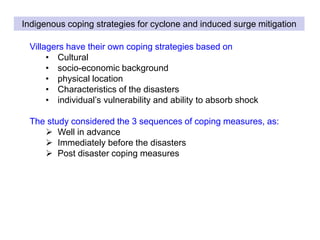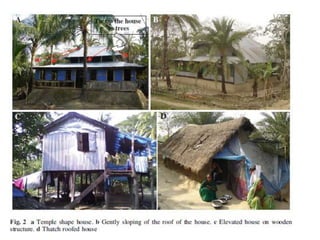Cyclones in bangladesh
- 1. Household response to cyclone and induced surge in coastal Bangladesh: coping strategies and explanatory variables Written By: Paul, S. K., & Routray, J. K. (2011) A presentation by MD ASIF HASAN Based of the paper
- 2. Purpose of this Study The purpose of this research is to explore indigenous coping strategies identify underlying demographic socio-economic and other relevant variables that influence the adoption of coping strategies It is assumed that such demographic and socio-economic variables have significant influence on the adoption of coping strategies against cyclones and induced surges. first section of this study the second section various indigenous coping strategies in response to cyclone and induced surge have been identified and discussed. the chi-square test is applied to various demographic and socio-economic variables such as age, gender, education, land ownership, income and occupation against different coping measures.
- 3. Introduction A review of existing literature finds that coastal flooding, cyclone and storm surge, the systematic documentation of indigenous knowledge and practices the identification of how different underlying factors influence coping behavior is still lacking. The present study intends to explore different pre-disaster during disaster and post-disaster coping measures effectiveness to mitigate the impacts of cyclones and induced surges on coastal Bangladesh. to explain how different variables such as age, gender, income, education, occupation, and other exogenous factors influence the adoption of coping measures.
- 4. The research is based on both secondary and primary data collected through key informant interviews, focus group discussions and a household questionnaire survey. Both descriptive and inferential statistics are used to analyze the data. By assuming a 95% confidence interval, the total sample size for the household questionnaire survey was 331 out of 788 households. Samples were drawn proportionately from three villages. Out of the total respondents approximately 90% are males and 10% are females. Methodology of this study and study area Angulkata Tetul Baria Charkashem Angulkata Tetul Baria Charkashem Population Sample 90% 10% Male Female
- 5. Study area
- 6. Affect Charkashem and Tatulbaria Villages • severely affected Angulkata • moderately affected Induced Surge cyclone induced surge height was • more than 3 m in Charkashem,Tatulbaria; • about 1.5 m in Angulkata Impacts and dynamics of cyclones and induced surges in the study villages Tube wells were submerged under saline water drinking and domestic water was highly polluted in Charkashem and Tatulbaria villages Water borne disease increase Water Borne Diseases
- 7. Indigenous coping strategies for cyclone and induced surge mitigation Villagers have their own coping strategies based on • Cultural • socio-economic background • physical location • Characteristics of the disasters • individual’s vulnerability and ability to absorb shock The study considered the 3 sequences of coping measures, as: Well in advance Immediately before the disasters Post disaster coping measures
- 8. Coping strategies well in advance of the cyclone and induced surge event • Unique design and construction method of houses- (Machan and Pataton) to save foods and goods are common strategies to minimize impact of the disaster. • Plantations of coconut, betel nut and banana trees around the house, gentle sloping of the house roof towards the south-east helps the wind to flow over the house • Put useful materials in a net or jute bag and throw these into a shallow pond or tie them to strong trees with cloth or rope • Most valuable items, such as jewelry, are wrapped in cloth and kept inside a cooking-hole in the kitchen or by digging a safety-hole in the floor to protect them from inundation and being washed away by the surge water.
- 9. 80% of total households do not have radio or television About half of the respondents do not understand the forecast, and few understand superficially or get some signals 85% of the fishermen do not have radios in their fishing boats; and rarely listen (81%) to weather forecasts. They generally depends on indigenous cyclone prediction methods: Abnormal south-eastern wind circulation along with a dark and cloudy sky (31%) The tendency of ants to climb walls carrying grain and moving purposefully towards higher ground or the roofs of houses (23%) Sea birds coming inland in groups (20%); Abnormal increase of water temperature in the sea and rivers (15%) Flies attaching themselves to cattle for protection against the surge water and wind (8%) Coping strategies well in advance of the cyclone and induced surge event contd
- 11. Coping strategies immediately before the cyclone and induced surge event Majority of the household members (86.4%) do not take shelter in traditional cyclone shelters, but prefer to stay in the ceilings or on top of the thatched roof of their own houses (35%), or seek refuge in neighbor’s houses (29.3%) No cyclone shelters are available in Charkashem and Tatulbaria. They (85.7 and 26.6% respectively) climbed up trees and stayed in their house ceilings until the threat was over A few people made use of plastic containers or banana rafts to save their lives from the fast flow of surge water Those who have no options, took shelter on the embankments, raised roads or other elevated places after the cyclone Majority of the respondents (49%) do not take any protective measures, as they believe – “Cyclone is God’s will and God will save them; it is beyond the control of people”
- 12. Post cyclone and induced surge event coping strategies Post event coping measures include risk management and risk coping strategies. After a cyclone more than 80% depend on alternative income sources Majority involved in government or NGO sponsored ‘food for work’ or ‘cash for work’ programs The study reveals that about 52, 47 and 14% in Angulkata, Tatulbaria and Charkashem villages respectively had sold assets, like: big trees, jewelry, household utensils, paddies, chickens, cattle, fish, tin sheets, fishing and agricultural equipment etc. Mortgaging of land was found most common in Angulkata Advance selling of labor also a common coping strategy
- 13. The study also reveals that borrowing of money is a common coping measure among 80% of total households; Major loan providers: NGOs 44.8% Mahajans / arotdars 19.5% friends/relatives 8.8% Government banks 4.8% Mal- practiced found as: people borrowed money simultaneously from multiple sources and used one source to repay another and thus they fall in the ‘vicious circle of borrowing’ Migration after a cyclone found as 13% cases Food scarcity make bound to reduce dailly meals formore than 90% of total respondents Post cyclone and induced surge event coping strategies contd
- 14. 14 Adoption of coping strategies: differentials and explanatory variables This study follows the socio-cultural approach to determine the variation in human coping due to the variation in socio-economic factors as follows: Age, Gender, Education level, Land ownership, Households Income, Primary Occupation. Response to early warning, locational exposure, magnitude of cyclonic events, relief and rehabilitation, social protection and informal risk-sharing within the community are also considered.
- 15. 15 It reveals that understanding of cyclone warning (p = 0.000) is higher among the upper income group (75.4%) and comparatively less among middle (49.7%) and lower income groups (39.6%). Household income
- 16. 16 disbelief in existing cyclone forecasts fear of theft fatalism unfavourable weather poor communication long distance and inadequacy of shelters Response to early warning Reasons behind not come to Cyclone Shelter
- 17. 17 Response to early warning 85 15 No move to Cyclone Shelter Move to Cyclone Shelter After Sidr 66.67 33.33 Move to Cyclone Shelter No move to Cyclone Shelter Rate of Change is 344%
- 18. 18 Char Area (Vulnerable for -Cyclone and Induced Surge) Sea Inland Community Lack of Resource and Become a part of Fishing Community Location exposure and magnitude of cyclone If surge water remains stagnant for an extended period, it pollutes both surface and drinking water. Spreading of water borne diseases reduces people’s coping ability and increases the state of vulnerability
- 19. 19 Relief Component Three months Time Period 1 times 2 times 3 times 4 times 5 times Rice Cash Cooking Oil Pulses Household Utensils Clothes Support Service Material Assistance for Rebuilding Local Economy Money for Rebuilding Local Economy Relief and rehabilitation
- 20. 20 Food for work Cash for work Household helped each other during cyclone & post cyclone period Manual labor Food sharing Home reconstruction materials Agricultural & fishing equipment and seeds Social protection and informal risk sharing within the community
- 21. 21 This study confirms that indigenous coping strategies can significantly minimize the cyclone vulnerability. Social protection measures along with informal risk-sharing mechanisms within the community play a vital role for rebuilding the settlements and the livelihoods of victims. The study finds that adoption of a particular set of coping strategies depends not only on the magnitude, intensity and potential impacts of the cyclone and induced surge, but also age, gender, social class, dissemination of early warning information, locational exposure, external assistance, social protection and informal risk sharing mechanisms within the community. Additionally, proper dissemination of early warning and government and non-government partnerships for relief and rehabilitation activities should be prioritized to ensure pro-poor disaster management activities. The study also recommends effective monitoring of the impact of aid to ensure corrective measures to avoid the development of relief dependency by disaster victims. Conclusion





















